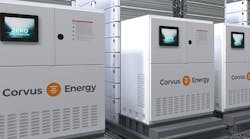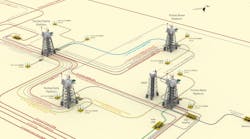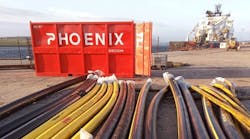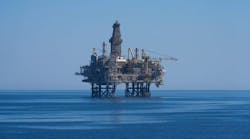Offshore Qatar's east coast, J.Ray McDermott has recently completed installation of the final wellhead platform in the production complex supplying the Ras Laffan Liquified Natural Gas (Ras Gas) Trains 1 and 2. These consist of a process platform, a living quarters platform, three wellhead platforms, a riser platform, and five interconnecting bridges.
Following bids for the upstream EPC (engineering, procurement, contracting) contracts, McDermott was awarded the platform construction work in 1996 under a joint venture with Chiyoda. The front-end engineering design for the offshore facilities was handled by McDermott's Hudson Engineering in Houston. Saipem was contracted for the Ras Laffan pipelines installation.
Under the lump sum contract for this project, J.Ray McDermott has been responsible for detailed engineering, procurement, yard fabrication, transport of pre-fabricated items to the offshore site, offshore installation, hookup, completion, and commissioning. The work scope covers the complete upstream facilities for the LNG project. The platform complex involved installation of nearly 25,000 tons of steel.
RasGas is a Qatari joint stock company formed to engage in the business of producing and selling LNG, condensate, and other hydrocarbon products. RasGas is 65.5% own ed by Qatar General Petro leum Corp. (Qatar owned), 26.5% by Mobil QM Gas, Inc. (wholly owned by Mobil), 4% by Otochu Corporation, and 3% by Nissho Iwai Corporation. A Korean entity is in the process of assuming a 5% equity interest in RasGas.
The company was established to produce from Qatar's giant offshore North Field, initially at a rate of 5 million tons/year of LNG through two 2.5 million tons/year trains. The second train was included as optional work under the existing contract. First LNG exports began in June 1999.
The project has been developed in two phases, with one onshore LNG train per phase. Offshore, Phase 1 work involved supply and installation of two wellhead platforms with a gathering pipeline, the main central complex, and the export line to shore. This complex serves Train 1.
Production layout
Ras Laffan's offshore production facilities are situated in 230 ft water depths, 94 km northeast of Ras Laffan. They can produce 1 bcf/d of gas, 38,500 b/d of unstabilized condensate, and handle 2,000 b/d of produced water. Gas and condensate are piped in a single, two-phase line to shore where they are separated - the gas is liquefied and the condensate stabilized.
Two of the three wellhead platforms are located 6-8 km from a facilities complex where the third is bridge-connected. Also in this complex are the bridge-linked process and utilities platform (PU), living quarters platform and emergency flare, with a bridge support structure for the flare and a riser platform for the 14-in. and 16-in. subsea gathering lines from the two remote wellhead platforms and the 32-in. export line to shore. There is also a 95-km fiber optic communications cable running directly to Ras Laffan, plus two six- km fiber optic/power cables between the remote wellhead platforms.
The PU platform dehydrates produced gas and removes free water from the condensate. Produced water is treated and then disposed overboard. There are no unusual topsides design features, according to McDermott, given that this is a high pressure, sour gas field, typical of those found in the Persian Gulf.
The scope of work for Train 2 was known as Wellhead 3 - this was a contract option exercised during the contract period. This involved fabrication of a third wellhead platform to supply the additional gas required to bring the system up to 1 bcf/d. (Train 1 has a 500 mcf/d throughput). Weight of the WH3 deck on completion was 870 tons. It left J.Ray McDermott's Jebel Ali yard in UAE on September 26 last year, with installation onto the jacket completed three days later by the derrick barge DB 27.
The most striking feature of the entire project to date was the PU deck installation in 1998. This was shipped out of Jebel A* on the CBL 102 floatover barge on July 31, arriving at the North Field the following evening. Once on location at the PU jacket (installed previously by the DB 27), the barge commenced entry into the PU jacket and 1 1/2 hours later, the barge was in position. Ballasting of the barge was undertaken using a deck-mounted external ballast system. After allowing for assistance from the falling tide, the sand jacks were released. Then, the triggers were activated, lowering the sand jacks, and effecting a successful deck/ barge separation.
The following day, final lowering of the deck was initiated by opening the valves on the sand cans and discharging the sand in a controlled manner. This discharge was measured by volume, while deck elevation was monitored using graduated scales marked up on each of the deck leg stabbing cones. Then, the deck was lowered to its final position and the deck legs welded.
J.Ray McDermott's Houston division is currently working on the front-end engineering design for two more LNG trains which will be needed to meet RasGas' long-term commitment to supply 7.5 million metric tons/year to Indian state company Petronet (starting in 2003). Both new trains reportedly will have a capacity of about 4 million metric tons/year, with the third train likely to be needed from January 2004. Gas for Train 2 has come from a previously unexploited part of the North Field, and the same may apply to the next two trains.





